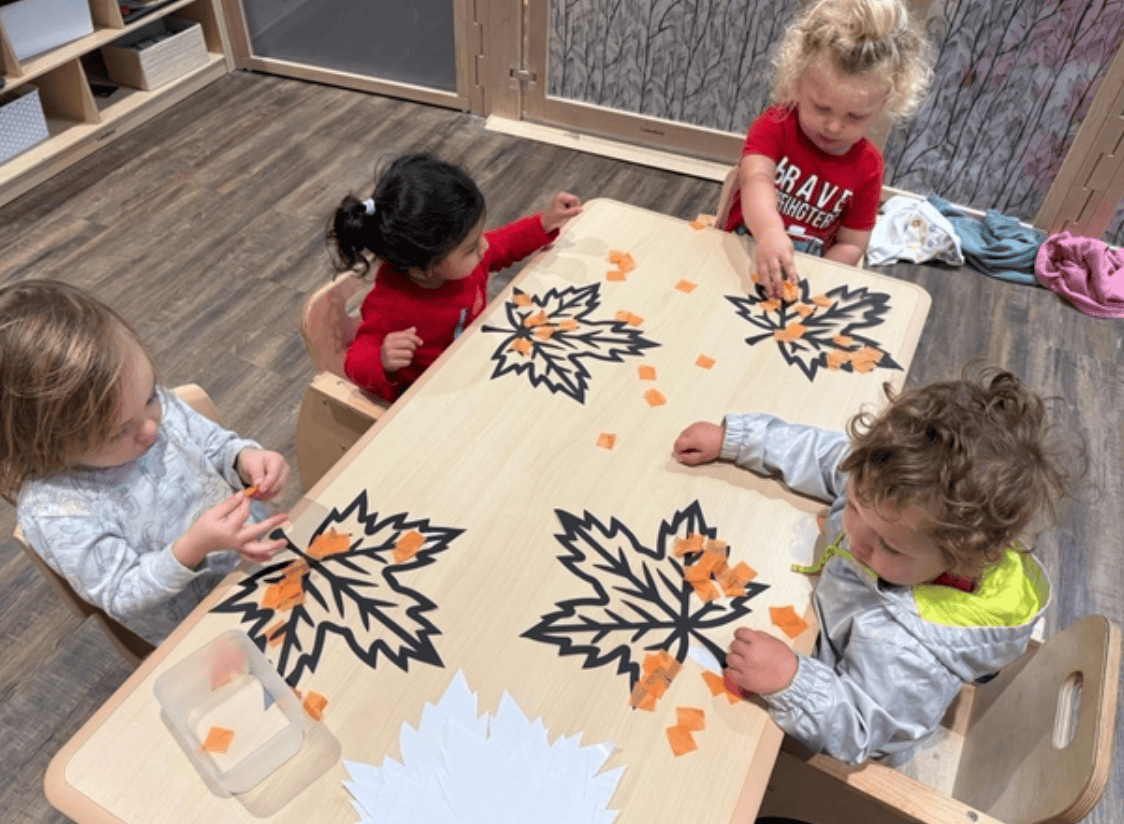
Fall is the perfect season to slow down, get cozy, and enjoy the little things with your toddler. With cooler weather, vibrant colors, and endless seasonal inspiration, autumn naturally invites playful learning. The best part? Simple fall activities can help toddlers build important developmental skills—like fine motor coordination, vocabulary, and sensory exploration—without ever feeling like “work.”
At Pillar Childcare, we love creating opportunities for toddlers to learn through play. Below are five fun, easy activities you can try at home this fall that are sure to spark joy, creativity, and growth.
1. Fall Leaf Collage
Why It Matters:
Toddlers love to explore with their hands—tearing, pressing, and gluing are not just fun, they build important fine motor skills. A leaf collage also sparks creativity and teaches toddlers to see beauty in everyday objects.
What You’ll Need:
- Paper with a large leaf outline (printable or hand-drawn)
- Tissue paper, construction paper, or old magazine scraps in fall colors
- Glue sticks or liquid glue
- Optional: child-safe scissors
Step-by-Step:
- Set up a simple workspace with the leaf outline in front of your toddler.
- Provide scraps of red, orange, yellow, and brown paper.
- Invite them to crumple, tear, or cut (if old enough) and glue the pieces onto the outline.
- Name colors out loud as they’re used: “That’s a bright red piece!”
Developmental Benefits:
- Fine Motor Skills: Strengthens little hand muscles through tearing and pressing.
- Creativity: Toddlers choose how to place colors and shapes.
- Language Growth: Naming colors reinforces early vocabulary (NAEYC).
Fun Variations:
- Add natural leaves collected outdoors for a sensory twist.
- Use stickers or glitter for extra sparkle.
- Create a “fall banner” by stringing several finished leaves together.
2. Nature Walk & Color Hunt
Why It Matters:
Toddlers are natural explorers, and a walk outdoors becomes a rich sensory classroom. Pointing out fall’s colors and textures helps children connect words to the world around them.
What You’ll Need:
- A small basket or paper bag
- Optional: a printed color chart or swatches made with crayons
Step-by-Step:
- Go for a short walk in your yard, park, or neighborhood.
- Collect treasures like leaves, pinecones, acorns, or sticks.
- As your toddler finds items, name their colors: “This leaf is yellow.”
- Compare textures: “This pinecone is bumpy. Can you find something smooth?”
Developmental Benefits:
- Observation Skills: Encourages toddlers to notice details.
- Vocabulary Expansion: Builds new words for colors, shapes, and textures.
- Connection with Nature: Creates early appreciation for the environment (Zero to Three).
Fun Variations:
- Turn treasures into art by gluing them on paper.
- Sort collected items by size or color at home.
- Create a “fall treasure basket” to display for daily play.
3. Apple Stamping
Why It Matters:
Toddlers learn best when they can see immediate cause and effect—like dipping an apple in paint and seeing a print appear. This hands-on art builds creativity while strengthening motor coordination.
What You’ll Need:
- Apples cut in half (seeds removed)
- Washable, non-toxic paint
- Paper
- A tray or plate for dipping
Step-by-Step:
- Slice the apples in half and dry the cut sides with a towel.
- Pour paint into a shallow tray.
- Dip the apple flat-side down and press onto paper.
- Point out shapes and colors as your toddler works: “That looks like a circle.”
Developmental Benefits:
- Hand-Eye Coordination: Learning to press and lift with control.
- Sensory Exploration: Feeling textures of apple and paint.
- Art Skills: Introduces basic printmaking and repetition (CDC).
Fun Variations:
- Use cookie cutters pressed into apple halves for unique designs.
- Create apple “trees” by stamping and painting trunks.
- Use stamped paper as gift wrap for grandparents.
4. Pumpkin Scoop & Sort
Why It Matters:
Pumpkins are practically made for toddler exploration. Scooping seeds builds sensory tolerance while sorting and counting build early math skills.
What You’ll Need:
- A pumpkin with top cut off
- Large spoon or scooper
- Bowls for sorting seeds
- Towels or newspaper for cleanup
Step-by-Step:
- Place the pumpkin on a protected surface.
- Invite your toddler to scoop seeds and stringy pulp into a bowl.
- Rinse seeds and sort by size, shape, or even color.
- Optionally roast seeds together for a family snack.
Developmental Benefits:
- Sensory Processing: Encourages tolerance of sticky textures.
- Sorting & Math Skills: Early categorization concepts.
- Family Bonding: Builds traditions around seasonal activities.
Fun Variations:
- Dye seeds with food coloring and use for crafts.
- Count seeds together to practice numbers.
- Add cornstarch to pumpkin guts to create “pumpkin slime.”
5. Leaf Dance Party
Why It Matters:
Movement is vital for toddlers. A leaf dance party is playful, active, and helps release energy while introducing rhythm and gross motor skills.
What You’ll Need:
- Dry leaves collected outdoors (or paper leaf cutouts)
- Music with an upbeat rhythm
Step-by-Step:
- Gather leaves into a pile and play lively music.
- Toss leaves in the air and encourage your toddler to jump, twirl, and catch them.
- Indoors, use paper cutouts or scarves as a substitute.
Developmental Benefits:
- Gross Motor Skills: Jumping, tossing, and twirling build coordination.
- Sensory Play: The crunch and sound of leaves stimulate multiple senses.
- Emotional Joy: Dancing and laughter support positive mood and bonding (Zero to Three).
Fun Variations:
- Play “freeze dance” with leaves.
- Pretend you’re autumn animals (squirrels, birds, or bears).
- Record a video and watch it back together—it adds another layer of fun.

Tips for Making Fall Activities Stress-Free
- Use what you have. Most activities only need paper, glue, or natural objects from outside.
- Set expectations. Activities may last 5 minutes or 30—both are normal.
- Embrace the mess. Messy play builds confidence. Lay down towels or work outdoors.
- Model the fun. Toddlers copy what they see—so join in.
- Connect to routines. Talk about leaves during storytime or count pumpkin seeds at snack time.
Remember: toddlers aren’t looking for perfect crafts—they’re looking for fun, love, and quality time.
Building Bright Foundations
Fall activities don’t have to be complicated or Pinterest-perfect to be meaningful. Whether it’s gluing scraps into a leaf outline, crunching leaves on a walk, or scooping pumpkin seeds, your toddler is gaining valuable skills while building joyful memories.
At Pillar Childcare, we believe in nurturing young minds through play, exploration, and creativity. Our programs are designed to give children the same opportunities for discovery and growth you’ve read about here—every single day.
Ready to give your child a strong start? Contact us today and discover how we can support your child’s growth.

